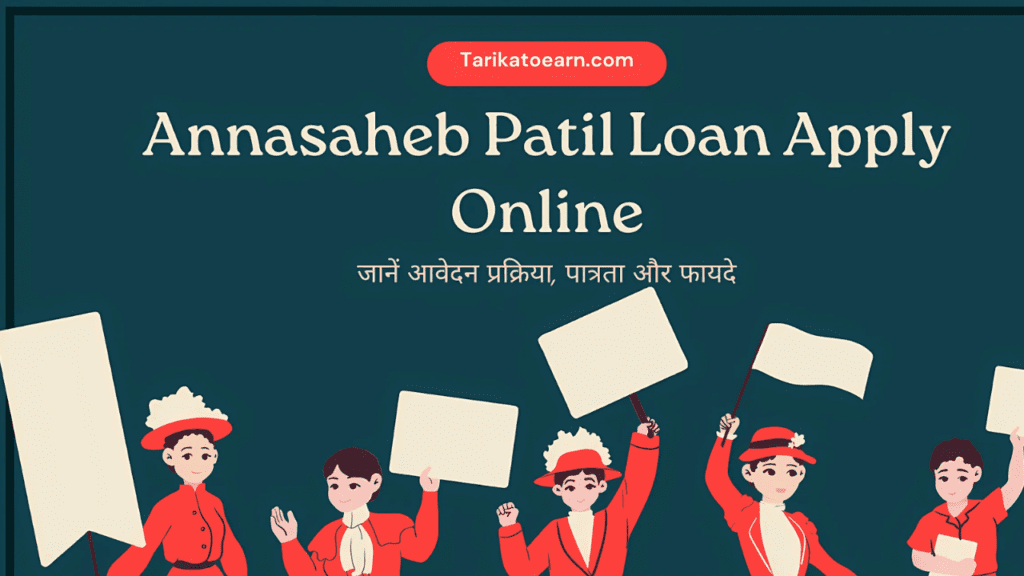
Annasaheb Patil Loan Apply Online:
The Annasaheb Patil Loan offers a straightforward way for individuals to access financial support online. Applying for this loan is as simple as filling out an online form, which can be completed from the comfort of one’s home. This convenience appeals to many looking for quick financial solutions without the hassle of traditional methods.
For those unsure about the process, there are loan consultants available to guide applicants. These professionals provide valuable assistance in navigating the application, ensuring that individuals meet the necessary criteria and submit accurate information.
Understanding the requirements and steps involved in the Annasaheb Patil Loan can lead to a smoother application experience. Whether seeking personal or business financing, this opportunity opens doors to various financial needs with minimal effort.
Eligibility Criteria for Annasaheb Patil Loan

To qualify for the Annasaheb Patil Loan, applicants must meet specific requirements. These include providing necessary documentation and satisfying qualifying conditions, which assess personal financial situations.
Documents Required
Applicants must submit a range of documents to support their loan application. The key documents typically include:
- Identity Proof: Aadhar card, voter ID, or passport.
- Address Proof: Utility bills, rental agreements, or government-issued documents.
- Income Proof: Salary slips, bank statements, or income tax returns for the last financial year.
- Credit Report: A recent credit report to determine creditworthiness.
In the case of individuals with a bad credit history, it is vital to include additional documentation explaining any defaults or financial hardships. Providing comprehensive and accurate documentation significantly increases the chances of approval.
Qualifying Conditions
The Annasaheb Patil Loan has specific qualifying conditions that potential applicants must fulfill. These include:
- Minimum Age: Typically, applicants must be at least 18 years old.
- Income Limit: There may be a cap on annual income, which can vary based on the lender.
- Credit Score: A good credit score is often a prerequisite. Generally, a score above 600 is considered favorable, but some lenders may accommodate lower scores for applicants showing steady income or repayment history.
Potential borrowers should assess their credit situation and prepare to explain any issues if they have bad credit. Understanding these criteria can streamline the application process.
Application Process
The application process for the Annasaheb Patil loan involves several steps that can be completed online. Applicants can easily track their application status after submission, ensuring they remain informed throughout the process.
Online Application Steps
- Visit the Official Website: Applicants should start by visiting the official Annasaheb Patil loan portal. This site contains all necessary forms and guidelines.
- Register/Login: New users must create an account by providing basic information. Existing users can log in using their credentials.
- Fill Out the Application Form: The form requires personal details, income information, and loan amount requests. It is crucial to complete all fields accurately.
- Upload Required Documents: Necessary documents such as ID proof, income statements, and bank statements must be uploaded. Ensure all files meet the specified format and size.
- Submit the Application: After reviewing the form and documents, applicants can submit their application for processing.
- Receive Confirmation: A confirmation message will be sent via email or SMS acknowledging the application submission.
Tracking Application Status
Tracking the application status is essential for staying updated. Applicants can follow these steps:
- Login to the Portal: Return to the official website and log into the account used for the application.
- Navigate to Application Status: Locate the “Application Status” section in the dashboard menu.
- Check Status Updates: The system will show the current status (e.g., under review, approved, rejected). This allows applicants to gauge the progress.
- Contact Support if Needed: If issues arise, applicants should reach out to customer service for clarification. Contact information is available on the website.
Using these methods, applicants can efficiently manage their loan applications with Annasaheb Patil, ensuring a smooth experience.
Loan Types and Their Features

Various loan types are available tailored to specific needs, offering unique features that can significantly benefit borrowers. Understanding these options helps individuals and businesses choose the right financial support.
Agricultural Loans
Agricultural loans are designed to support farmers and those involved in agriculture-related activities. These loans often include options for crop loans, which assist with pre-harvest expenses, and bakri palan loans, specifically aimed at livestock farming.
Key features include:
- Subsidized interest rates for eligible farmers
- Flexible repayment options based on harvest cycles
- Assistance with equipment and infrastructure financing
Programs such as the farmer loan redemption scheme in Uttar Pradesh aim to alleviate existing debts, promoting sustainable farming practices.
Small Business and Entrepreneurship Loans
Small business loans are crucial for individuals looking to start or expand a business. Loans may be offered by government schemes or private institutions, including business loans in Kerala and DIC loans.
Essential features encompass:
- Tailored amounts based on the business model and requirements
- Repayment flexibility, often extending up to five years
- Access to mentorship programs and business development resources
Such loans empower entrepreneurs to enhance their business potential effectively.
Women Empowerment and Savings
Loans targeting women are geared towards promoting financial independence and entrepreneurship. The Mahila Samman Savings Certificate is a notable initiative that combines savings with attractive interest rates for women.
Key aspects include:
- Special loan schemes with reduced interest rates
- Support for business ventures led by women
- Financial literacy programs to enhance economic participation
The Annabhau Sathe Loan program also focuses on facilitating women’s access to credit, ensuring they can pursue their economic goals confidently.
Gold Loans and Investment
Gold loans serve as a financial solution leveraging gold assets, while gold itself is a well-regarded investment option. Understanding both aspects can help individuals make informed decisions regarding their finances.
Understanding Gold Loans
Gold loans are secured loans wherein individuals pledge their gold jewelry or coins as collateral. Institutions like Gramin Bank offer competitive gold loan interest rates, making it an accessible option for many borrowers. The process is typically fast, requiring basic documentation and sometimes minimal credit checks.
The amount sanctioned depends on the value of the gold pledged. Borrowers can receive funds quickly and often benefit from lower interest rates compared to unsecured loans. They should compare offers from different lenders, including Chemmanur Gold Loan, to find the best terms.
Gold as an Investment
Investing in gold has long been favored for its stability and potential for appreciation. Many investors view gold as a hedge against inflation and economic uncertainty. Questions like “Is gold a good investment?” often arise, and the answer depends on personal financial goals.
Gold tends to retain its value over time and sometimes appreciates during market downturns. This makes it a valuable asset. Investors should consider diversifying their portfolios by including gold, alongside traditional assets.
Understanding local options, such as Keerthana Gold Loans, can provide further insights into investment choices in gold.
Educational Loans
Educational loans provide vital financial support for students pursuing higher education. These loans can help cover tuition fees, living expenses, and other educational costs. It is essential to understand the various options available and the procedures involved in obtaining these loans.
NBFCs and Education Loans
Non-Banking Financial Companies (NBFCs) offer educational loans that cater to students’ diverse financial needs. Unlike traditional banks, NBFCs often have more flexible eligibility criteria.
- Benefits of NBFC Education Loans:
- Quicker approval times.
- Less stringent documentation requirements.
- Customized repayment plans.
Some notable NBFCs providing educational loans include HDFC Credila, which specializes in financing education abroad and offers competitive interest rates. They also provide an online portal for the loan application process, making it convenient for students to access funds. Personal loans for students with no job are also available through certain NBFCs, easing financial pressure for those without a regular income.
Education Loan Sanction Process
The loan sanction process generally involves several steps. Initially, students must submit an application along with required documentation, which typically includes:
- Admission proof.
- Course details.
- Financial statements.
After submission, the lender reviews the application and assesses the student’s eligibility. Upon approval, the education loan sanction letter is issued, outlining the loan amount, interest rate, and repayment terms.
Students should monitor the sanction process through the lender’s online platform. Communication remains crucial at this stage to ensure all requirements are met promptly. The timely submission of documents and responding to queries can facilitate a smoother sanction process.
Home Loan Options
Home loan options vary based on the lender type and government schemes available, catering to diverse financial needs. Understanding these options is key for consumers seeking the best financing for their property requirements.
Bank and NBFC Home Loans
Banks and Non-Banking Financial Companies (NBFCs) offer various home loan products. For instance, the JK Bank housing loan typically has competitive interest rates, making it suitable for many borrowers. Additionally, institutions like Mahindra Home Loan provide flexible repayment terms.
Borrowers with a low CIBIL score can still access options, but might face higher interest rates or specific terms. For example, JM Financial Home Loans may cater to such customers with tailored plans to improve accessibility.
One notable aspect is the SBI Home Loan, which provides a free CIBIL score check, helping clients assess their eligibility. Clients can also take advantage of schemes like the Pradhan Mantri Awas Yojana – Urban (PMAY-U) to benefit from subsidies on interest rates, making home ownership more attainable.
Government-Aided Home Loans
Government-aided home loans are specifically designed to encourage home ownership, especially among lower-income groups. PMAY offers subsidies on interest rates for eligible borrowers, particularly benefiting first-time homebuyers.
These loans often require minimal documentation and facilitate easier processing. Consumers can access lower interest rates compared to traditional loans. This is significant for individuals with constrained financial capacities.
Additionally, schemes such as the SBI PM Swanidhi Loan Online – Eazytonet help small businesses and low-income individuals gain access to housing finance. This illustrates the government’s commitment to making home loans accessible to a broader demographic.
In summary, government and private sector collaboration enhances home loan options available to the public.
Assistance for Disabled Individuals
Individuals with disabilities may face unique financial challenges. The Annasaheb Patil loan program offers support tailored to their needs, facilitating access to necessary resources.
Types of assistance available:
- Handicapped Loans: These loans specifically cater to individuals with disabilities, providing favorable terms.
- Financial Aid: Eligible individuals can receive grants or financial assistance for purchasing equipment or modifying homes.
- Skill Development Programs: These initiatives help disabled individuals acquire new skills, enhancing employability and financial independence.
Loan Features:
- Low Interest Rates: Loans for disabled individuals often come with lower interest rates compared to standard loans.
- Flexible Repayment Options: Borrowers can benefit from extended repayment periods, allowing manageable monthly payments.
Eligibility Criteria:
- Applicants must provide documentation of their disability.
- Verification of income may be required to assess financial need.
Those interested in applying can do so online, simplifying the application process. Awareness of available resources can empower individuals with disabilities to take charge of their financial future.
Credit Building Strategies

Building credit requires strategic actions that can lead to an improved credit score. Two key strategies involve the effective use of credit cards and ways to quickly enhance credit scores.
Effective Use of Credit Cards
Using credit cards wisely can significantly impact one’s credit score. A good credit score generally falls between 700 and 749. To build credit, individuals should aim to use less than 30% of their total credit limit. This is known as the credit utilization ratio.
Choosing the right credit card is crucial. Options like student cards or secured credit cards are excellent for those starting their credit journey. Making payments on time is vital, as late payments can lead to credit score drops. Individuals should also consider becoming an authorized user on someone else’s card to benefit from their positive credit history.
Improving Credit Scores Quickly
There are several strategies to enhance credit scores in a short amount of time. Paying off existing debts, especially those in collections, can yield a quick boost. Another effective method is requesting a credit limit increase, which can lower the overall utilization ratio.
Regularly checking credit reports for errors is essential. Disputing inaccuracies can lead to score improvements. Moreover, making multiple payments throughout the month instead of one lump sum can lower utilization before reporting dates.
For those with bad credit, personal loans can also serve as a tool for rebuilding credit. Successfully managing a personal loan payment history can positively affect overall credit health.
Personal Loan Options
Personal loan options vary significantly to cater to different financial needs. Individuals seeking quick access to funds or those facing challenges with credit scores can benefit from various loan types.
Payday Loans and Short-Term Credits
Payday loans offer quick cash solutions for urgent financial needs. These loans typically have short repayment periods, often due on the borrower’s next payday.
Key Features:
- Instant Approval: Many lenders approve payday loans rapidly, sometimes within hours.
- Accessibility: These loans are available even to those with poor credit history.
- High Interest Rates: Borrowers should be cautious of high-interest rates associated with short-term loans.
In cities like Bangalore and Mumbai, payday loans are readily available through numerous lenders. Daily collection loans also fall under this category, providing flexibility in repayment options.
Loans for Individuals with Low CIBIL Scores
Individuals with low CIBIL scores often face difficulties securing traditional loans. Fortunately, alternative options exist tailored for them.
Key Options:
- Salary Advance Loans: These allow borrowers to access part of their salary before the payday without a stringent credit assessment.
- Personal Loans with Bad Credit: Some lenders specialize in offering loans to individuals with poor credit, often requiring minimal documentation.
It’s essential for borrowers to review the terms carefully, as these loans can come with higher fees and interest rates. Understanding the implications of taking such loans is crucial for financial planning.
Financial Planning and Management
Financial planning and management are crucial for individuals considering the Annasaheb Patil loan. A structured approach ensures effective use of funds and helps in achieving financial goals.
Key Steps in Financial Planning:
- Set Clear Goals
Define short-term and long-term financial objectives. - Create a Budget
Outline income and expenses to understand cash flow. - Emergency Fund
Allocate savings to cover unexpected costs.
Calculating Retained Earnings
Retained earnings reflect the cumulative profits a company retains for reinvestment. The formula is:
[ \text{Retained Earnings} = \text{Previous Retained Earnings} + \text{Net Income} – \text{Dividends} ]
This figure helps assess financial health and guides investment decisions.
Effective Management Strategies:
- Track Expenses: Regularly monitor spending to identify areas for savings.
- Review Financial Statements: Analyze income statements and balance sheets for informed decision-making.
- Adjust Financial Plans: Be flexible and modify plans based on changing financial conditions.
Implementing these strategies leads to better management of personal finances and more successful loan repayment. Staying organized and informed is essential for achieving financial stability.
Loan Interest Rates and Terms
Understanding the interest rates and terms associated with loans is crucial for borrowers. Various lenders offer different rates that directly impact the total cost of borrowing.
Comparing Bank Loan Interest Rates
Bank loan interest rates can vary significantly. For instance, Repco Bank offers competitive home loan interest rates that typically range from 8.5% to 9.5%. This can be advantageous for borrowers seeking affordable options.
Cooperative banks also provide attractive rates, often around 8.0% to 9.0%. Gramin Bank’s home loan interest rates are similarly structured, frequently falling between 8.25% and 9.0%, making them suitable for rural borrowers.
In contrast, Motilal Oswal Home Loan rates may start at 8.4% and can differ based on the borrower’s credit profile. Borrowers should carefully compare these rates to find the best fit for their financial situation.
Non-Banking Financial Corporations (NBFCs)
NBFCs offer flexibility in loan terms and interest rates, although they may be higher than traditional banks. For example, Oroboro loans can feature interest rates ranging from 10.0% to 15.0%, contingent on the borrower’s risk profile.
DG Loan providers often have competitive terms, but interest rates can reach 12.0%, reflecting the risk involved. Borrowers should analyze the additional fees and terms associated with NBFC loans.
While NBFCs might offer quicker processing, the higher interest rates necessitate careful consideration. It is essential for borrowers to calculate the long-term costs of choosing an NBFC over a traditional bank to ensure informed decisions.
